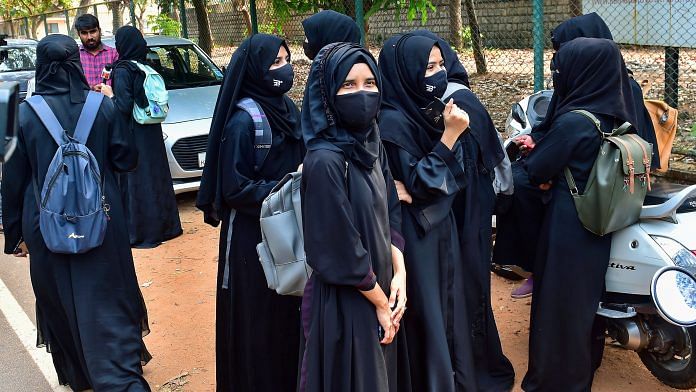Karnataka has emerged as the new battlefield to decide whether hijab can be accepted as part of a girl’s uniform in public schools or not. The BJP government in Karnataka and their supporters argued that this controversy has been ignited by Campus Front of India, a student wing of PFI, which is accused of colluding with terrorist entities like al-Qaeda to spread radicalisation in Kerala and other Indian states. The other side hit out at the Right-wing brigade for spreading frivolous conspiracies and charged BJP for following apartheid-like policies where girls in hijab are made to sit in different classrooms because the matter is subjudice.
The harmless piece of clothing has landed in controversy not just in India but in most parts of the world. To fight off Islamophobia in Western nations, 1 February is celebrated as World Hijab Day. It supports the religious identity of Muslim women who are the victims of stereotypes, hatred, prejudice and sexism in white, ‘progressive’ world.
Unfortunately, this symbol of resistance often becomes a tool of systemic oppression in Islamic countries. Various accounts of brave women have been reported who are serving sentences or have been murdered for taking off of their hijab. To acknowledge the struggle of these women for whom this attire is suffocating at the very least, ex-Muslim and Canadian activist Yasmine Mohammad started the initiative in 2017 to mark no-hijab day on the same day.
In this matter, advocate Devadatta Kamat, who appeared on behalf of petitioners, quoted verses from Quran and Hadith to back the argument that wearing of hijab is an essential practice under Islamic law and if banned, must be treated as violation of fundamental rights guaranteed under Article 19 & 25 of the Indian Constitution.
Also read: Is hijab a choice? India can’t defend secularism on knife’s edge, like France
Religious freedom different for men and women
Some activists and celebrities argued that when Sikh men wear their turban it is assumed they wear it out of choice but on the contrary, hijab-wearing Muslim women are popularly believed to be oppressed by their conservative families. But those who are in favour of this opinion should realise that gendered reality for men and women is different and thus cannot lend to such simplistic comparisons.
The religious obligation to practice modesty in daily life is not similar for both genders. Men have devised a way to accommodate their needs and desires with the religion they practice. The flexibility to conveniently discard or follow the religious beliefs/customary rituals is exclusive to the masculine gender, and this overt freedom gives them an option to even choose a life that is deemed immoral according to their very own religion.
Instead of comparing Muslim women to Sikh men, it’s more sensible to relate the experiences of women from different religious backgrounds. For instance, in December last year, the marriage of two Sikh women with Kashmiri Muslim men were forcibly called off in Kashmir. The Sikh groups alleged that both were kidnapped and converted to Islam but the women themselves denied these allegations. Later, one of the two women was married to a Sikh man against her will.
Similarly, many BJP-ruled states in India have introduced legislation to prevent the so-called ‘love jihad’ and inter-faith marriages specifically between Hindu women and Muslim men.
These are just a handful of examples that corroborates India’s 140th position out of 156 countries in the 2021 Global Gender Gap Report published by the World Economic Forum. For a woman in India, it is a privilege to assert choice and follow dreams. Most of the time, they have to make peace with the deep-rooted patriarchy of the rigid family structure where their roles are predetermined by religious texts and scriptures.
Many in India are even batting for things like the Uniform Civil Code and French model of secularism, Laïcité, to be at least adopted in school education. This need for ‘uniformity’ and coercing everyone to wear the same type of clothes, eat vegetarian food, watch sanskari (Hindu traditional mannerism) content to please the majority mindset is leaving a stain on the diverse fabric of this nation. Introduction of such impractical concepts in the Indian context will cost us our democracy which has already become flawed and fragile in the last few years.
The literacy rate among Muslim women in India is even lower than other marginalised communities like Scheduled Caste and Scheduled Tribes. Due to poor outreach of education, Muslim women contribute less than ten per cent of the total female workforce participation, according to the National Sample Survey Organisation (NSSO) data.
Wearing of hijab or any outfit should not be an obstacle for women to get desirable education and achieve financial independence. At the same time, every religion needs a renaissance to eliminate the bigotry and fundamentalism that has fixed a ceiling for women in the name of feminine virtues.
The author is a student at St. Aloysius College, Jabalpur. Views are personal




